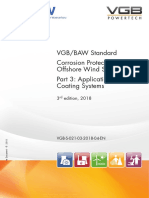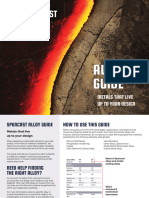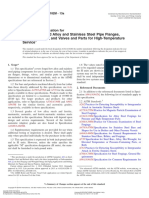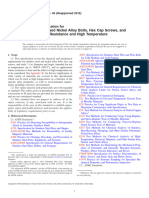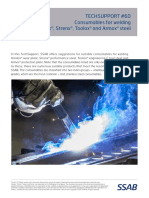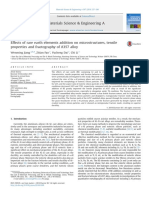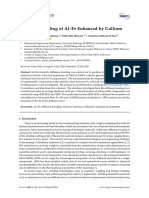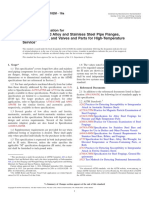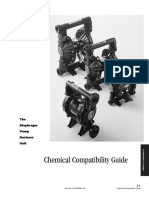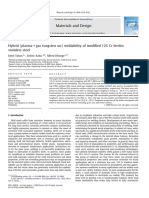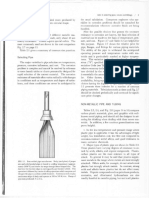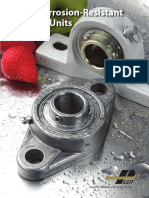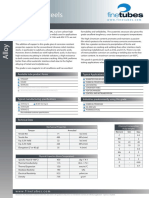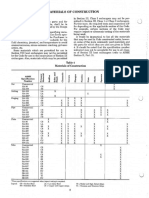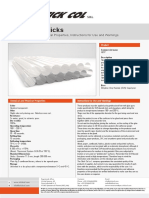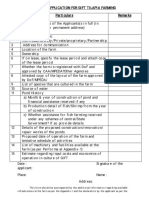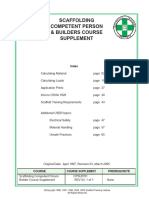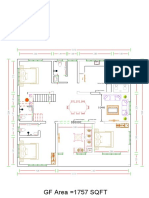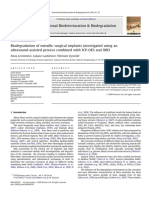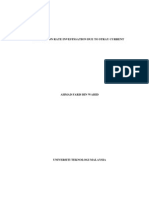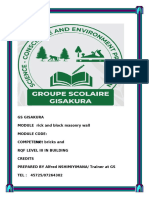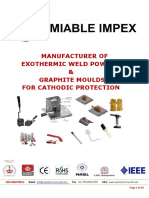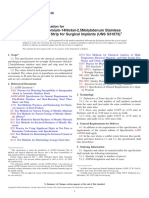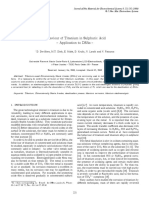Chemical Resistance Guide: General
Chemical Resistance Guide: General
Uploaded by
Leon PeterCopyright:
Available Formats
Chemical Resistance Guide: General
Chemical Resistance Guide: General
Uploaded by
Leon PeterOriginal Description:
Original Title
Copyright
Available Formats
Share this document
Did you find this document useful?
Is this content inappropriate?
Copyright:
Available Formats
Chemical Resistance Guide: General
Chemical Resistance Guide: General
Uploaded by
Leon PeterCopyright:
Available Formats
PRODUCT INFORMATION
Chemical resistance guide
GENERAL
Our valves are available to control most Corrosion occurs either as a chemical or Mixtures of different fluids and their tempera-
acids, alcohol, bases, solvents and corro- electro-chemical reaction. Therefore, con- tures are not included in this table. Its the
sive gases and liquids. Modified or special sideration must be given to both the galvanic users responsibility to ensure the chemical
designs are sometimes required depending and electromotive force series, as well as to and physical compatibility of the body and
upon the fluid and application. pressure, temperature and other factors that other materials with the fluids used.
might be involved in the application. For applications where abnormal conditions
This guide provides information on most exist and for other types of valves, opera-
common corrosive and non-corrosive, un- tions and fluids, contact us with full details
mixed gases and liquids. of the operating conditions.
fluids body materials other materials in contact with fluid
= Excellent
stainless steel
stainless steel
stainless steel
= Acceptable
AISI 303/304
aluminium
AISI 316L
= Not recommended
cast iron
AISI 316
Copper
bronze
EPDM
= Do not use
PEEK
Silver
FFPM
brass
PTFE
steel
POM
NBR
FPM
PPS
PET
TPE
CR
UR
PA
- = No data available
Acetaldehyde
Acetic acid
Acetic anhydride
Acetone
Acetonitrile - - - - - - -
Acetophenone - - - - - - -
Acetyl chloride - -
Acetylene
Air (lubricated) - -
Air (unlubricated, dry) - -
Alcohol ethyl (ethanol) - -
Alcohol methyl (methanol) -
Aluminium sulfate
Ammonia, anhydrous
Ammonia, aqueous - -
Ammonia, water - - -
Ammonium hydroxyde
Amyl acetate -
Aniline
Argon - -
Barium chloride -
Barium hydroxide -
Availability, design and specifications are subject to change without notice. All rights reserved.
Benzaldehyde
Benzene pure
Benzene sulfonic acid
Borax -
Bromine -
Butadiene - -
Butane -
Butanol (aqueous, butyl alcohol) -
Butylene - -
Butyl acetate
Butylamine - - - -
Butyl ether - - - -
Calcium chloride -
Calcium sulfate -
Carbon dioxide (wet/dry) -
Carbon tetrachloride
Caustic soda - - -
00013GB-2013/R01
Cellosolve - - - -
Please note that the chemical resistance may be influenced by many factors, such as temperature, concentration, etc.
This data is for information only.
All leaflets are available on: www.asconumatics.eu
153
Chemical resistance guide - PRODUCT INFORMATION
fluids body materials other materials in contact with fluid
= Excellent
stainless steel
stainless steel
stainless steel
= Acceptable
AISI 303/304
aluminium
AISI 316L
= Not recommended
cast iron
AISI 316
Copper
bronze
EPDM
= Do not use
PEEK
Silver
FFPM
brass
PTFE
steel
POM
NBR
FPM
PPS
PET
TPE
CR
UR
PA
- = No data available
Chlorobenzene
Chloroform
Chlorosulfonic acid -
Chlorine (wet) - -
Chromic acid (25%)
Chromic acid, concentrated -
City gas - - - - - - - - - - -
Coffee - - - - -
Coke oven gas - - - - - - -
Detergent - - -
Diesel fuel -
Dimethyl formamide -
Dimethyl phtalate - - - - - -
Ethylene chloride
Ethylene diamine - - -
Ethylene dichloride
Ethylene glycol
Ethylene oxide -
Ferric chloride
Ferrous chloride -
Formaldehyde
Formic acid -
Freon 11
Freon F-12 -
Freon 22 -
Freon T WD602 - - - - - - -
Fuel oil -
Fuel oil #6 - - -
Fuel ASTM Ref Fuel A - - - -
Fuel ASTM Ref Fuel B - - - -
Fuel ASTM Ref Fuel C - - - -
Fuel ASTM #1 Oil - - - - -
Fuel ASTM #2 Oil - - - - -
Fuel ASTM #3 Oil - - - - -
Fuel ASTM #4-5 Oil - - - - -
Furan - - - - - - - - -
Furfural -
Gasoline (petrol) - -
Availability, design and specifications are subject to change without notice. All rights reserved.
Gasoline 100 octane - - - - - - - -
Glycogenic acid - - - - - - - - -
Glycol - - - - -
Helium - - -
Heptane -
Hydraulic fluids - - -
Hydraulic oil -
Hydrofluoric acid (50%)
Hydrogen gas -
Hydrogen peroxide (30%) -
Hydrogen sulfide (dry hot)
Isobutylene - - - - - -
Jet fuels (JP1 through 5) - - - -
Jet fuels (JP 6) - - - - - -
Kerosene (kerosine)
Lactic acid -
Liquid natural gas (LNG) - - - - - - - - - - - - - - - - -
00013GB-2011/R01
Liquid oxygen (LOX) - - - - - -
Please note that the chemical resistance may be influenced by many factors, such as temperature, concentration, etc.
This data is for information only.
All leaflets are available on: www.asconumatics.eu
154
Chemical resistance guide - PRODUCT INFORMATION
fluids body materials other materials in contact with fluid
= Excellent
stainless steel
stainless steel
stainless steel
= Acceptable
AISI 303/304
aluminium
AISI 316L
= Not recommended
cast iron
AISI 316
Copper
bronze
EPDM
= Do not use
PEEK
Silver
FFPM
brass
PTFE
steel
POM
NBR
FPM
PPS
PET
TPE
CR
UR
PA
- = No data available
Liquid petroleum gas (LPG) - - - - - -
Lubricating oils, di-ester - - - - -
Lubricating oils, petroleum base - - - - -
Lubricating oils, SAE 10, 20, 30, 40 - - - - - -
Magnesium acetate - - - - - - - -
Magnesium hydroxide
Methane
Methyl ether ketone (MEK)
Mineral oil -
Morpholine - - - - - - - -
Naphta -
Natural gas
Nitric acid (10%) -
Nitric acid, concentrated -
Nitro benzene -
Nitro methane - - -
Nitrogen
Nitro propane - - - - - - - - - - -
Octane - - - - - - - - - - - - -
Octane carboxylic acid - - - - - - - - - - - - - - - - - - - -
Octanol - - - - - - - - - - - - - - -
Oleic acid - -
Olive oil - - - -
Oxygen, cold - - - - - - - -
Oxygen 121 - 204C (250 - 400 F) - - - - - - - - - - - - - -
Oxygen, gas - - - - - -
Ozone (dry) -
Palm oil - - - - - - - - -
Palmic acid - - - - -
Paraffin - - -
Pentane - - - - - -
Pentanol - - - - - - - - - - - - - - - - -
Perchloroethylene (Perk) -
Petrol - - -
Petroleum benzine - - - - - - - -
Petroleum ether - - - -
Petroleum naphtha - - - - - - - - -
Petroleum oil above 121C (250F) - - - - - - - -
Availability, design and specifications are subject to change without notice. All rights reserved.
Petroleum oil below 121C (250F) - - - - - -
Phenol
Phenilic acid - - - - - - - - - - - - - - -
Phosphoric acid 10% -
Phosphoric acid, concentrated
Pine oil - - - - -
Poly propylene glycol - - - - -
Potassium acetate - - - - - - -
Potassium bicarbonate - - - - - - - -
Potassium carbonate - - - - - -
Potassium chloride
Potassium hydroxide (50%)
Potassium nitrate -
Potassium phosphate - - - - - - - -
Potassium sulfate - - -
Propane -
Propanol - - - - - - - -
00013GB-2011/R01
Propylene - - - - -
Please note that the chemical resistance may be influenced by many factors, such as temperature, concentration, etc.
This data is for information only.
All leaflets are available on: www.asconumatics.eu
155
Chemical resistance guide - PRODUCT INFORMATION
fluids body materials other materials in contact with fluid
= Excellent
stainless steel
stainless steel
stainless steel
= Acceptable
AISI 303/304
aluminium
AISI 316L
= Not recommended
cast iron
AISI 316
Copper
bronze
EPDM
= Do not use
PEEK
Silver
FFPM
brass
PTFE
steel
POM
NBR
FPM
PPS
PET
TPE
CR
UR
PA
- = No data available
Propylene chloride - - - - - - - - - - -
Pydraul 10E, 29ELT - - - - - - - - - -
Pyridine -
Saccharose - - - - - - - - -
SAE oils - - - - - - - - - - - - - - - -
Salt water - - - -
Soda - -
Sodium carbonate - -
Sodium chloride
Sodium hydroxide (caustic soda)
Sodium hypochlorite
Sour natural gas - - - - - - - - - - - - - - -
Steam to 107C (225F) - - - -
Steam 107 - 148C (225 - 300F) - - - - - -
Steam over 148C (300F) - - - - - -
Stoddard solvent - - -
Sulphur dioxide, liquid -
Sulphuric acid, concentrated
Tetrachloroethylene - - -
Tetrahydrofuran - - - -
Toluene -
Tri chloro ethylene -
Tri chloro acetic acid - - -
Turpentine -
Vaseline - - - - - - - - -
Vegetable oils - - - - - -
Vinegar -
Water - - - - - - - - - - - -
Water, acid mine - - - -
Water, deionized - - - -
Water, distilled lab -
Water, drinking - - - - - - - - - -
Water, fresh - -
Water, heavy - - - - - - - - - - -
Water, sea/river -
Water glass - - - - -
Waterproofing salt - - - - - - -
Xenon - - - - -
Availability, design and specifications are subject to change without notice. All rights reserved.
Xylene
Zinc chloride
Please note that the chemical resistance may be influenced by many factors, such as temperature, concentration, etc.
This data is for information only.
00013GB-2011/R01
All leaflets are available on: www.asconumatics.eu
156
You might also like
- VGB S 021 03 2018 04 enDocument37 pagesVGB S 021 03 2018 04 enCarmen Rodriguez Polo100% (2)
- Astm A217 A217m 2010 PDFDocument4 pagesAstm A217 A217m 2010 PDFPedro SilvaNo ratings yet
- ASTM A985 Investment CastingDocument12 pagesASTM A985 Investment CastingBobNobbitsNo ratings yet
- 02 CertificateDocument1 page02 CertificateLeon PeterNo ratings yet
- Alloy Guide 1 31 2023Document14 pagesAlloy Guide 1 31 2023Vijay KumarNo ratings yet
- TAPPI TIP-0402-26 Welding of SS PipingDocument13 pagesTAPPI TIP-0402-26 Welding of SS Pipinga_parratNo ratings yet
- ASTM A182-A182M 13aDocument16 pagesASTM A182-A182M 13aHarry NielsenNo ratings yet
- F2281 - Stainless Steel and Nickel Alloy Bolts, Hex Cap Screws, and Studs, for Heat Resistance and High Temperature Applications - 2004 (2012)Document10 pagesF2281 - Stainless Steel and Nickel Alloy Bolts, Hex Cap Screws, and Studs, for Heat Resistance and High Temperature Applications - 2004 (2012)vg47tt6q5rNo ratings yet
- TS931 Techsupport 60 enDocument8 pagesTS931 Techsupport 60 enMOHAC KILICASLANNo ratings yet
- Weldability and Mechanical Properties of DissimilaDocument8 pagesWeldability and Mechanical Properties of DissimilaDANIELA LIZETH DIAZ MENCHACANo ratings yet
- 1 s2.0 S1005030215002108 MainDocument9 pages1 s2.0 S1005030215002108 MainDr. Rachid djoudjouNo ratings yet
- Jiang Et Al. - 2014 - Effects of Rare Earth Elements Addition On Microstructures, Tensile Properties and Fractography of A357 AlloyDocument8 pagesJiang Et Al. - 2014 - Effects of Rare Earth Elements Addition On Microstructures, Tensile Properties and Fractography of A357 AlloyRahul GuptaNo ratings yet
- Jiang Et Al. - 2014 - Effects of Rare Earth Elements Addition On Microstructures, Tensile Properties and Fractography of A357 Alloy PDFDocument8 pagesJiang Et Al. - 2014 - Effects of Rare Earth Elements Addition On Microstructures, Tensile Properties and Fractography of A357 Alloy PDFRahul GuptaNo ratings yet
- Ayu Arwati 2018 IOP Conf. Ser.3A Mater. Sci. Eng. 343 012016Document9 pagesAyu Arwati 2018 IOP Conf. Ser.3A Mater. Sci. Eng. 343 012016LuuThiThuyDuongNo ratings yet
- Stainless Steel Welding PDFDocument16 pagesStainless Steel Welding PDFWilmer Howard BenderNo ratings yet
- Diffusion Bonding of Al-Fe Enhanced by GalliumDocument9 pagesDiffusion Bonding of Al-Fe Enhanced by Gallium2022353017No ratings yet
- Effect of Filler Metals On The Mechanical Properties of Dissimilar Welding of Stainless Steel 316L and Carbon Steel A516 GR 70Document6 pagesEffect of Filler Metals On The Mechanical Properties of Dissimilar Welding of Stainless Steel 316L and Carbon Steel A516 GR 70Isaac SimbañaNo ratings yet
- 304 SS Grade SS 304Document3 pages304 SS Grade SS 304S.Mohana sundaramNo ratings yet
- Overview of Stainless Steel and Stainless Plate - Stainless Processing, Inc. - Coatesville, PennsylvaniaDocument7 pagesOverview of Stainless Steel and Stainless Plate - Stainless Processing, Inc. - Coatesville, Pennsylvaniahgagselim2012No ratings yet
- 15-5 PH Data Bulletin PDFDocument12 pages15-5 PH Data Bulletin PDFAndres Camilo BenitezNo ratings yet
- Temperature Effects On Stainless Steel 316L Corrosion in The Environment of Sulphuric Acid (H2SO4)Document9 pagesTemperature Effects On Stainless Steel 316L Corrosion in The Environment of Sulphuric Acid (H2SO4)Amaldev NVNo ratings yet
- A 182 - A 182M - 16a PDFDocument15 pagesA 182 - A 182M - 16a PDFأسامة وحيد الدين رمضانNo ratings yet
- 2021 Influence of Immersion Corrosion AISI 430 AISI 316L - IJE - Volume 34 - Issue 5 - 2021Document11 pages2021 Influence of Immersion Corrosion AISI 430 AISI 316L - IJE - Volume 34 - Issue 5 - 2021cesold delcaribeNo ratings yet
- Al AgingDocument122 pagesAl AgingDevi Eka Septiyani ArifinNo ratings yet
- Grac Ochem CompatibilityDocument28 pagesGrac Ochem Compatibilitylatasharma79No ratings yet
- 4.4 Welding Consumables: Copper-Nickel Welding and Fabrication - 9Document1 page4.4 Welding Consumables: Copper-Nickel Welding and Fabrication - 9satnamNo ratings yet
- ASTM A 182 Standard Specification For Forged or Rolled Alloy.2005 PDFDocument17 pagesASTM A 182 Standard Specification For Forged or Rolled Alloy.2005 PDFAndres Afanador Muñoz100% (1)
- Astm A217Document5 pagesAstm A217saeedNo ratings yet
- Materials and Design: Emel Taban, Erdinc Kaluc, Alfred DhoogeDocument7 pagesMaterials and Design: Emel Taban, Erdinc Kaluc, Alfred DhoogeZahra MaylaNo ratings yet
- Atomic Structure of STAINLESS STEEL E316Document8 pagesAtomic Structure of STAINLESS STEEL E316Parikshit UjoodhaNo ratings yet
- X-Ray Diffraction JournalDocument9 pagesX-Ray Diffraction JournalSREEJITH S NAIRNo ratings yet
- The Effect of Repeated Repair Welding On Mechanical and Corrosion Properties of Stainless Steel 316LDocument12 pagesThe Effect of Repeated Repair Welding On Mechanical and Corrosion Properties of Stainless Steel 316LRami GhorbelNo ratings yet
- Huang 2016Document9 pagesHuang 2016Rami GhorbelNo ratings yet
- BMEDocument1 pageBMEAmitNo ratings yet
- Aalco Metals LTD Stainless Steel ASTM A815 S31803 261Document2 pagesAalco Metals LTD Stainless Steel ASTM A815 S31803 261Irvin PajueloNo ratings yet
- Stainless Steels Martensitic PDFDocument9 pagesStainless Steels Martensitic PDFAbhinandan Admuthe100% (1)
- Legend FittingsDocument10 pagesLegend FittingsAndy SetyawanNo ratings yet
- Stainless Steel ASTM A815 S31803: Specifications Alloy DesignationsDocument2 pagesStainless Steel ASTM A815 S31803: Specifications Alloy Designationsallouche_abdNo ratings yet
- Standard Specifications Type Characteristics Applications Aisi JIS Others AstmDocument4 pagesStandard Specifications Type Characteristics Applications Aisi JIS Others Astmsiva100% (1)
- Rbe All Fluids Modular Couplings Staubli - enDocument28 pagesRbe All Fluids Modular Couplings Staubli - enPaul WoodwardNo ratings yet
- Metals and Alloys in Dentistry: Review 215Document22 pagesMetals and Alloys in Dentistry: Review 215Saad LiaqatNo ratings yet
- PEER Bearing UnitsDocument6 pagesPEER Bearing Unitsmaxx.blyumNo ratings yet
- Astm A182 2015Document16 pagesAstm A182 2015Lėo GuimarãesNo ratings yet
- Product Categories: Fittings, Valves, Clamps & Accessories For Hose, Pipe and TubeDocument35 pagesProduct Categories: Fittings, Valves, Clamps & Accessories For Hose, Pipe and TubeRaj DomadiyaNo ratings yet
- Lecture 4Document12 pagesLecture 4Sbongokuhle MhlunguNo ratings yet
- 1198-Article Text-6980-1-10-20230701Document15 pages1198-Article Text-6980-1-10-20230701Riyas SahabNo ratings yet
- ASTM A182 Stander DataSheetDocument16 pagesASTM A182 Stander DataSheetYusuf KhoirNo ratings yet
- Stainless Steels: Alloy 904L (UNS N08904)Document1 pageStainless Steels: Alloy 904L (UNS N08904)MV ABNo ratings yet
- Heff 5Document2 pagesHeff 5Amorntep AiadphaeNo ratings yet
- A182 PDFDocument16 pagesA182 PDFExport priminoxNo ratings yet
- ASTM A182 BallDocument16 pagesASTM A182 Ballsigurdur hannessonNo ratings yet
- Astm A193Document12 pagesAstm A193Brad BorgesNo ratings yet
- A037 Glue Sticks: Product, Chemical and Physical Properties, Instructions For Use and WarningsDocument1 pageA037 Glue Sticks: Product, Chemical and Physical Properties, Instructions For Use and Warningsralf casagdaNo ratings yet
- BTFY Keystone Ar1 Ar2Document4 pagesBTFY Keystone Ar1 Ar2tali011971No ratings yet
- 006 AluminumDocument102 pages006 AluminumPartagon PowNo ratings yet
- Fatigue Life of The 316L Stainless Steel Based On Dual-Parametric Weibull DistributionDocument10 pagesFatigue Life of The 316L Stainless Steel Based On Dual-Parametric Weibull DistributionMr PolashNo ratings yet
- Guidelines For Specification, Welding and Inspection of Stainless Alloy Piping Craig Reid, P.EngDocument19 pagesGuidelines For Specification, Welding and Inspection of Stainless Alloy Piping Craig Reid, P.EngFinnFan8100% (1)
- Stainless Steel Material: 300 SeriesDocument1 pageStainless Steel Material: 300 SeriesNamal WanninayakeNo ratings yet
- Temperature Effects On Stainless Steel 316L Corrosion in The Environment of Sulphuric Acid (H2SO4)Document8 pagesTemperature Effects On Stainless Steel 316L Corrosion in The Environment of Sulphuric Acid (H2SO4)sandrineguerin2012No ratings yet
- Welding Metallurgy and Weldability of Nickel-Base AlloysFrom EverandWelding Metallurgy and Weldability of Nickel-Base AlloysRating: 5 out of 5 stars5/5 (1)
- Oxy-Acetylene Welding and Cutting Electric, Forge and Thermit Welding together with related methods and materials used in metal working and the oxygen process for removal of carbonFrom EverandOxy-Acetylene Welding and Cutting Electric, Forge and Thermit Welding together with related methods and materials used in metal working and the oxygen process for removal of carbonNo ratings yet
- Sabish Chirayil Sasi: ObjectiveDocument2 pagesSabish Chirayil Sasi: ObjectiveLeon PeterNo ratings yet
- Annexure IvDocument1 pageAnnexure IvLeon PeterNo ratings yet
- Tilapia Application Form & GuidelinesDocument7 pagesTilapia Application Form & GuidelinesLeon PeterNo ratings yet
- CP08 Supplement March 05Document80 pagesCP08 Supplement March 05Leon PeterNo ratings yet
- OmniOMS Output GenerationDocument1 pageOmniOMS Output GenerationLeon PeterNo ratings yet
- CP05 Inspection Manual March 05Document12 pagesCP05 Inspection Manual March 05Leon PeterNo ratings yet
- ATM Request LetterDocument1 pageATM Request LetterLeon PeterNo ratings yet
- Material CostDocument58 pagesMaterial CostLeon Peter100% (1)
- PdmsDocument1 pagePdmsLeon PeterNo ratings yet
- Malayalamprayer PDFDocument3 pagesMalayalamprayer PDFLeon PeterNo ratings yet
- ASTS - ProspectusDocument8 pagesASTS - ProspectusLeon PeterNo ratings yet
- States Under The Jurisdiction of The Washington D.C. Office (East Coast)Document2 pagesStates Under The Jurisdiction of The Washington D.C. Office (East Coast)Leon PeterNo ratings yet
- Print Plan1 PDFDocument1 pagePrint Plan1 PDFLeon PeterNo ratings yet
- Bonafide CertificateDocument1 pageBonafide CertificateLeon Peter0% (1)
- DUBAI 2 Model PDFDocument1 pageDUBAI 2 Model PDFLeon PeterNo ratings yet
- Key - 1Document237 pagesKey - 1Leon Peter100% (3)
- Abuse Activist Activity Actor Actress Actual Actually Ad Adapt Add Addition Additional Address Adequate Adjust Adjustment AdministrationDocument165 pagesAbuse Activist Activity Actor Actress Actual Actually Ad Adapt Add Addition Additional Address Adequate Adjust Adjustment AdministrationLeon PeterNo ratings yet
- For FillingDocument3 pagesFor FillingLeon PeterNo ratings yet
- Isometrics PDFDocument8 pagesIsometrics PDFLeon PeterNo ratings yet
- 597 NR - 2017 01 PDFDocument58 pages597 NR - 2017 01 PDFSutan Aditya100% (1)
- Comparison of Earthing Systems by StandardsDocument3 pagesComparison of Earthing Systems by StandardsPrasadNo ratings yet
- Evaluating Cracking in ConcreteDocument7 pagesEvaluating Cracking in ConcreteEvello MercanoNo ratings yet
- Paint Systems For Steel StructuresDocument7 pagesPaint Systems For Steel StructuresHermann Lowe100% (1)
- Din 1670Document10 pagesDin 1670GODREJ LAB THANENo ratings yet
- 3LPE CoatingDocument7 pages3LPE CoatingSathish P Sathish PalanichamyNo ratings yet
- UPP Product Catalogue PDFDocument31 pagesUPP Product Catalogue PDFJR RZNo ratings yet
- 34 Samss 711Document25 pages34 Samss 711naruto256No ratings yet
- Cable Tray SystemsDocument45 pagesCable Tray SystemsAmin Hasan AminNo ratings yet
- Biodegradation of Metallic Surgical Implants Investigated Using Anultrasound-Assisted Process Combined With ICP-OES and XRDDocument5 pagesBiodegradation of Metallic Surgical Implants Investigated Using Anultrasound-Assisted Process Combined With ICP-OES and XRDmustafaNo ratings yet
- Bacteria in Closed HeatingDocument4 pagesBacteria in Closed HeatingGeorge MarkasNo ratings yet
- Corrosion Rate Investigation Due To Stray CurrentDocument69 pagesCorrosion Rate Investigation Due To Stray CurrentN'FNo ratings yet
- !!elevation New MS WordDocument90 pages!!elevation New MS WordvalensmusaNo ratings yet
- GDC BrochureDocument124 pagesGDC BrochuremolarexpressNo ratings yet
- Cathodic Protection CatalogDocument18 pagesCathodic Protection CatalogfarukNo ratings yet
- TDS Antifrogen L EnglishDocument8 pagesTDS Antifrogen L EnglishCaZias EoiNo ratings yet
- 7 - HDPE Pipes 2019 CATLOG PDFDocument16 pages7 - HDPE Pipes 2019 CATLOG PDFTASNEEMNo ratings yet
- ME Program Guide 2011Document47 pagesME Program Guide 2011sagarsononiNo ratings yet
- ASTM F139-08 Standard Specification For Wrought 18chromium 14nickel 2.5molybdenum Stainless Steel Sheet and Strip For Surgical ImplantesDocument4 pagesASTM F139-08 Standard Specification For Wrought 18chromium 14nickel 2.5molybdenum Stainless Steel Sheet and Strip For Surgical ImplantesJoãoNo ratings yet
- Corr Lab ReportDocument10 pagesCorr Lab ReportSAFINA KAMAL SHOILYNo ratings yet
- Ite M Completed Comments: Tank Out-Of-Service Inspection ChecklistDocument14 pagesIte M Completed Comments: Tank Out-Of-Service Inspection Checklistmindbag100% (1)
- Mumbai University Bachelor of Engineering COMPUTERS Revised SyllabusDocument26 pagesMumbai University Bachelor of Engineering COMPUTERS Revised SyllabusNaresh GuthulaNo ratings yet
- Part1 Trunking 31 7 19 Compress PDFDocument14 pagesPart1 Trunking 31 7 19 Compress PDFMohd Haziq Mohd YunusNo ratings yet
- Construction, and Maintenance of Relief Wells PDFDocument92 pagesConstruction, and Maintenance of Relief Wells PDFArif RusyanaNo ratings yet
- SP1246 Part-5 PDFDocument23 pagesSP1246 Part-5 PDFMohammad Aamir Perwaiz100% (1)
- Protective Coating System ISO-12944-5 Pinturas TIKURILLADocument2 pagesProtective Coating System ISO-12944-5 Pinturas TIKURILLAmiguel0581No ratings yet
- TDS 2023oct - Galvashield - SM DASDocument3 pagesTDS 2023oct - Galvashield - SM DASvivekNo ratings yet
- 5 Question (Diaphragms Pressure Sensor)Document2 pages5 Question (Diaphragms Pressure Sensor)Solehah OmarNo ratings yet
- Behaviour of Titanium in Sulphuric Acid - Application To DsasDocument12 pagesBehaviour of Titanium in Sulphuric Acid - Application To DsasShijuNo ratings yet
